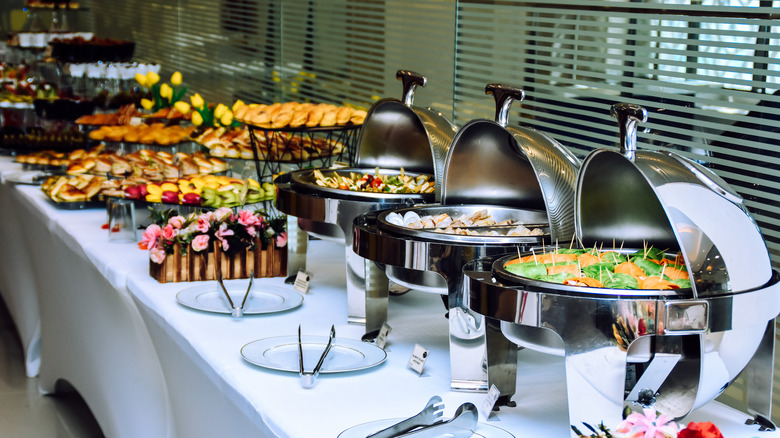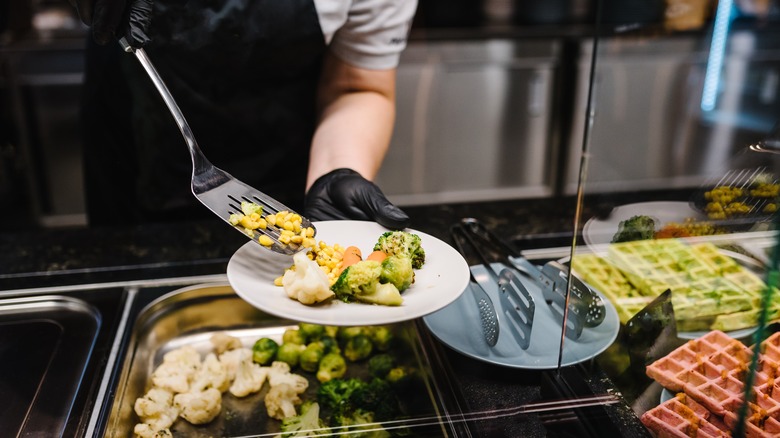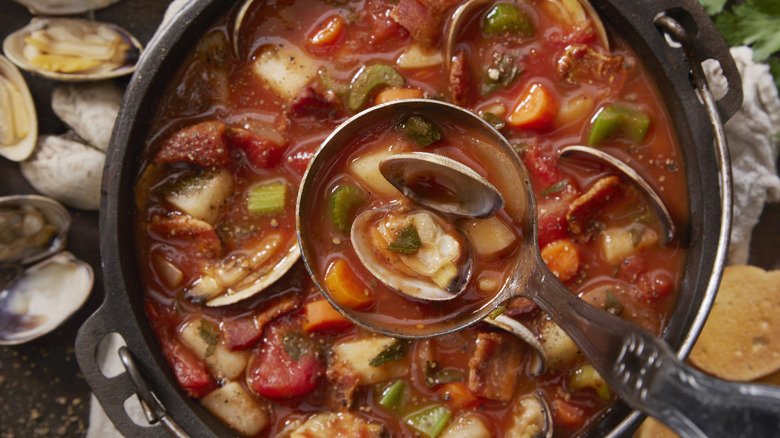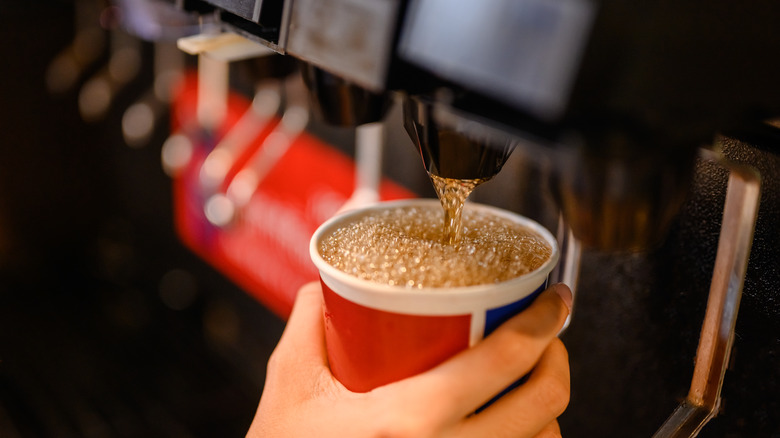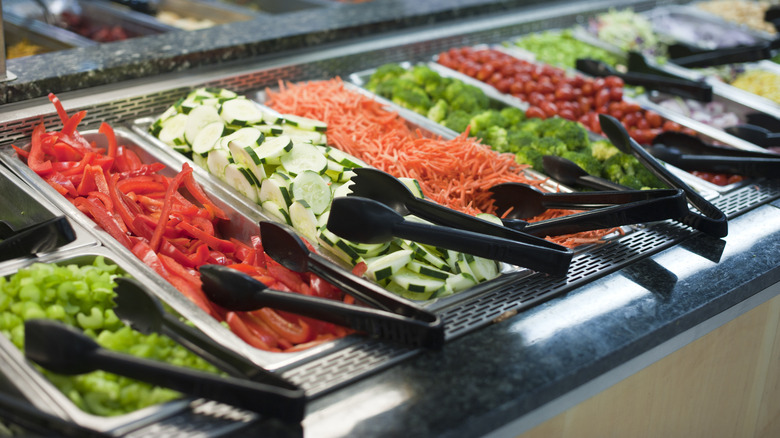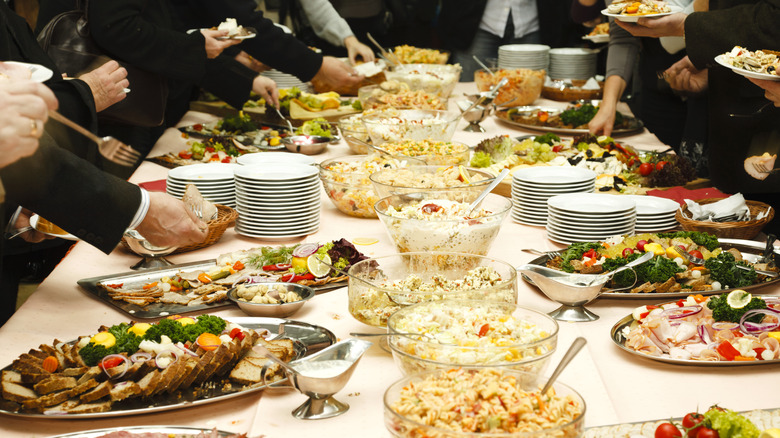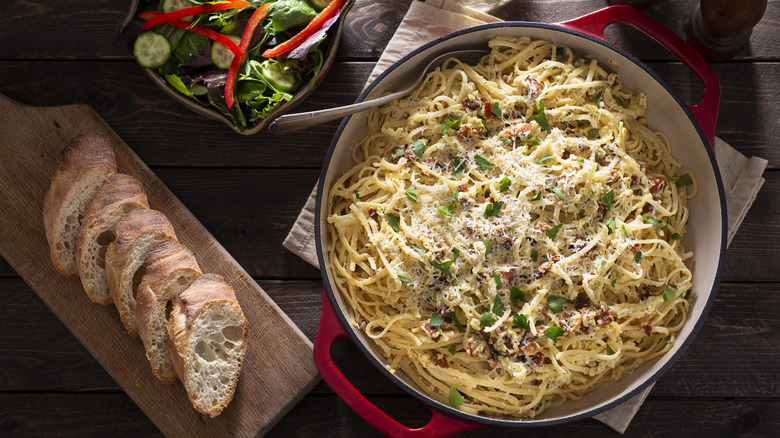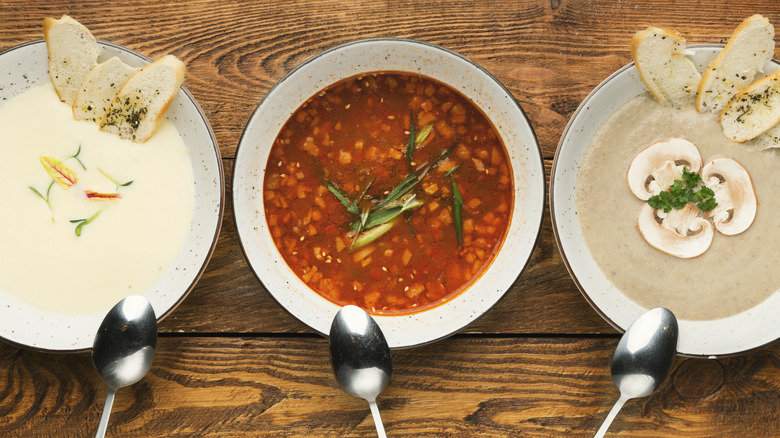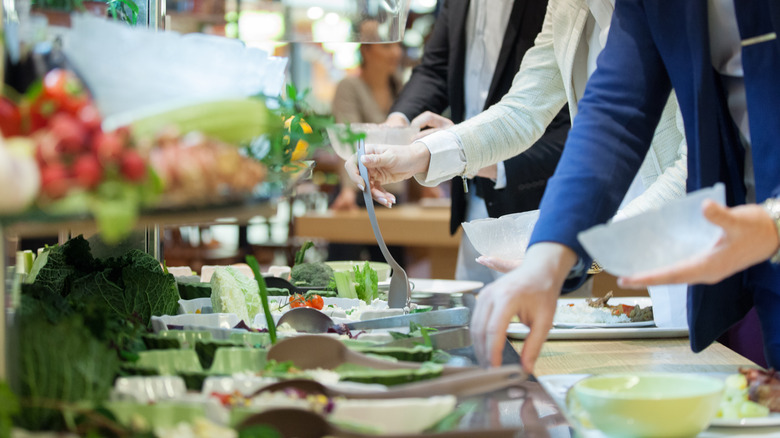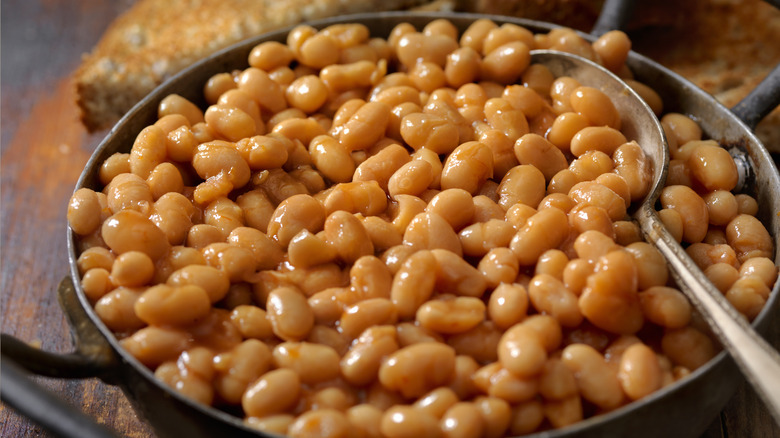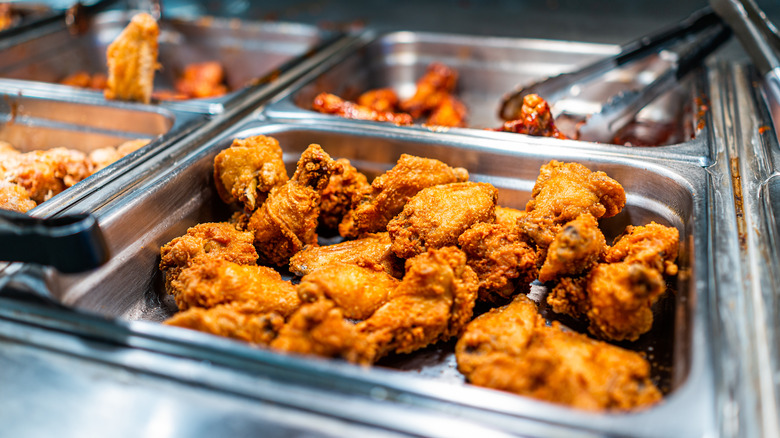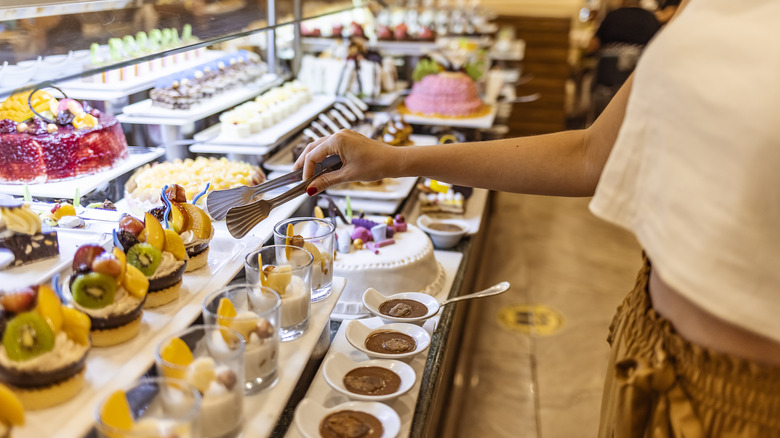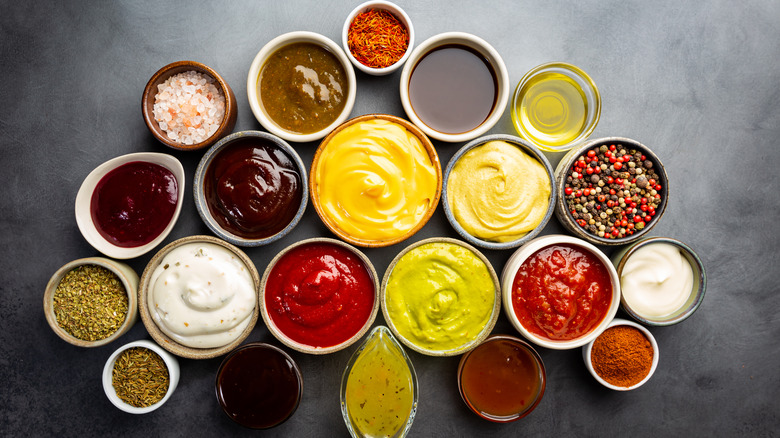Tricks All-You-Can-Eat Buffets Use To Fill You Up
Have you ever found yourself standing at a restaurant buffet, filled with an insatiable hunger and a bottomless stomach, ready to conquer a limitless array of deep-fried classics, creamy stews, and prime cuts? Yet, despite your won't-stop-for-anything mindset and your pre-game preparations to get your money's worth, you end up surrendering to gluttony after just a few rounds.
We've all experienced that futile attempt to outeat the all-you-can-eat platters of crab legs and the never-ending flow of soda. But here's the thing: Being so full before you make it to the dessert station may not be entirely your fault. There are various factors at play, both behind the scenes in the kitchen and in the strategically designed dining hall, that contribute to the quantity and speed you consume food at buffets. In fact, the truth about all-you-can-eat buffets may be right under your nose and leave you questioning the authenticity of the experience.
While you might even call buffets scams once you uncover these trade secrets, there isn't one single ingredient that can explain why you magically end up feeling too stuffed to continue. Nonetheless, let's dive into the ways buffets subtly influence your decisions at the dinner table and put you in a losing position right from the get-go.
Portions are closely controlled
All that meat and piles of pastries are technically ours for the taking, but how do buffets make money if everything is up for grabs? Despite the illusion of unlimited food, buffets ensure that nothing on the menu is truly ours by manipulating our sense of control and influencing our decisions.
While buffets enable our strange food combinations without judgment, they also influence our food choices and the volume we put on our plates. To the restaurants, we might as well be mindless zombies with a bottomless appetite. Their job is to fill our bellies as quickly as they can by steering our gullible mouths toward the most filling options while discouraging the more expensive dishes.
Next time you visit a buffet, look at how the salads and sides are presented in generous proportions, while that succulent lamb roast is carefully supervised by a server at the carving station. That stunning sea of salads is there to entice us to try them all, while the server expertly slices the meat paper-thin to precisely control how much of it we get.
By cutting down on the availability of costlier items while making sure the filling food is served in excess, buffets can make us fuller more quickly, saving money in the process. Bonus points for them if you'd rather stuff your mouth with appetizers than meekly ask a judgmental server for a second (or third) plate of red meat.
Kitchen utensils are chosen with a purpose
Don't blame the masterminds behind buffets for how stuffed you are halfway through dinner — the true culprits may be right in your hands. Every detail, from the silverware and dishware to the serving spoons and soup bowls, is carefully curated to maximize or minimize the amount of food you eat.
If you observe the serving utensils at a buffet, you'll notice that oversized spoons are used for cost-efficient, filling foods like vegetables, while tiny tongs are reserved for more expensive options like meat. Even your plates and bowls are intentionally downsized, a characteristic of a secret buffet line of standard equipment. Smaller plates, though they stop you from grabbing more than you can eat, encourage multiple trips to the buffet, creating the illusion of being fuller despite only taking smaller portions.
Another tactic that buffets employ is to slow your eating pace with carefully chosen utensils. For example, those smaller forks make you eat more slowly, which ultimately makes you full faster. Even chopsticks are made readily available instead of silverware at Asian buffets since they are more challenging to handle unless you're an expert. It just goes to show the extent to which these tactics control what's in your hands.
All those little sips in large glasses add up
There's nothing more satisfyingly refreshing than a tall glass of carbonated liquid to make space in your stomach after filling it with starch. That's what they say right? In fact, you might be falling right into the trap set by buffet restaurants.
If you're only paying attention to the solid food you are consuming and disregarding your beverage choices, it could explain why you're always quick to quit and miss out on the other delectable dishes at the buffet. The truth is, all those liquid calories add up, and all-you-can-eats use three tricks to make you feel fuller quicker: bigger glasses, sugary drinks, and lots — we mean lots — of water.
The one thing that is essentially free at a buffet is water, so it makes sense that the glasses are huge enough to fill you up with liquid at a minimal cost. Moreover, sugary, empty-calorie drinks, which some people can't do without, also load up the calories and make restaurants more profit as they are often sold separately and marked up significantly. Both these drinks are the least expensive items for restaurants to purchase, so how else do they leverage this free get-you-full-quick technique? By offering free refills of course!
Food placement and layout is strategic
As much as we want to preserve the wonder of walking up to a Sunday lunch buffet like it's Disneyland and marveling at the dazzling arrays of delicious food — the reality of all-you-can-eat buffets is far from magical. Although the food display may seem random to the untrained eye, the buffet layout is meticulously designed to guide our decisions.
Cheaper, more filling options such as vegetables and rice are strategically positioned at the beginning of the buffet. A salad bar may also stand in your way, tempting you to load your plate with inexpensive yet substantial salads, soups, or bread. This specific layout is designed to make it harder to resist these items and easier to overeat them.
Not only that, but the big guns like steaks, seafood, and expensive desserts are also nearly impossible to find — they're always at the end of the buffet line, sparingly served, and concealed by cheaper fare. Some buffets only bring them out once every customer's hunger has subsided and they are too full to eat. Occasionally, they may advertise delicacies but hide them so effectively that they might as well not be available at all.
With the secret now unveiled, these establishments — once cherished havens where we could freely choose our favorite dishes — are really just mazes where we, the unwitting subjects, are manipulated into making choices we are no longer in control of.
So many choices, so little time
We all know that buffets are successful because of the vast variety of food available. From delicious meats cooked in every way possible to shrimp balls and endless pies, the freedom of choice is hard to pass up. However, the multitude of options is also a targeted tactic to alter our dining experience and lead us to feel full faster.
As human beings, we are naturally drawn to new experiences and flavors, and buffets are designed to trigger our instinct to try as many things as we can. There will always be something that will appeal to almost anyone at buffets, and even picky eaters may be tempted to try new foods out of curiosity. This plays perfectly into the buffet's strategy of encouraging us to continuously refill our plates with a little bit of everything until we unknowingly become too full.
Moreover, the wide range of colors, aromas, and textures stimulates our appetite, making us more excited to experience the dishes and more likely to eat beyond our usual limits. So, even if we're only sampling each delicacy one at a time, it becomes extremely hard to keep track of how much we've eaten when we're so preoccupied with the task at hand. It's not easy to concentrate when overwhelmed by the choices, but mindfulness is a surefire way to enjoy such feasts.
Starchy foods are served for quick satisfaction
You're three plates in — even though you originally planned to take on twice as much — and feeling uncomfortably full. As you unbutton your pants you wonder, "How did I let this happen?" The answer may lie in the empty plates before you that were piled high with potatoes, rice, pasta, and bread.
While it may seem like a great deal to load your plate with generous servings of golden fried rice and dinner rolls as a way of getting the best bang for your buck, these starchy and gluten-rich foods are actually inexpensive fillers strategically designed to satiate you quickly and affordably.
This is because starchy foods are rich in carbohydrates, which are broken down into glucose. Starch can be easy to overeat, and food companies, including buffets, capitalize on this by enhancing the starchiness of their offerings, triggering the immediate pleasure response in our brains. Coupled with the fact that buffets often exclude whole-grain versions of these foods and prominently feature them at the beginning of the buffet line, we are all the more compelled to choose the options that add bulk to our meals at a minimal cost, while also failing to provide the nutritional value we expected.
So, when you find yourself feeling satiated after just one round at the buffet, survey your dinner table. You might have picked up too many potatoes and pizza slices and fallen into the trap of consuming these low-cost fillers.
Creamy dishes fill you up fast
We all know the health implications of eating too much butter and cream, yet it's incredibly difficult to say no to these thick and appetizing fill-me-ups — especially at all-you-can-eat buffets. Loaded with high-calorie and high-fat creams and butter, buffets offer a plethora of soups, stews, broths, and pasta, tempting us to indulge by the ladleful.
These dishes often contain fattening sauces and come paired with carbs and fiber-rich food such as potatoes, lentils, beans, or grains, which are meant to slow our buffet game down. Additionally, the liquid content of soups and stews also promotes a sense of fullness and keeps us satiated for longer periods.
Don't be fooled by pasta dishes with seemingly light sauces or those healthy-looking soups. White sauces in pasta are intentionally enriched with saturated fats that make you full, while soups may be glazed with unhealthy oils. Instead, opt for red sauces like marinara for your pasta and avoid bisques as they often have a higher fat content. By giving the creamy serving trays a wide berth, you'll avoid unnecessary fillers and focus on the more valuable options available at the buffet.
Cheap greens galore
If you hadn't already noticed, the reason why buffets are affordable is because they prioritize cheap and easily accessible ingredients and dishes. The abundance of vegetables and proteins served by the buckets gives the illusion of being costly, however, these items are actually intended to minimize costs and, unfortunately, contribute to filling us up quickly.
Vegetables like lettuce, cabbage, spinach, and broccoli, as well as proteins such as eggs, chicken, and pork, can be inexpensive if they are purchased in bulk or sold during peak season. The one thing they have in common is that they efficiently and economically fill us up. Trust us, you'll notice these foods dominating the buffet spread, appearing at every turn. Even the seemingly harmless buffet salad bars that folks sometimes start with add bulk to your plate, contributing to that infamous fullness buffets are known for.
So here are a few pro tips to keep in mind for your next buffet outing: Avoid the meatloaf, as it may contain cheaper cuts of meat padded with bread, and always question why that chicken pot pie is served in huge slices while the fine meats come in small cubes.
High-fiber foods are not always diet-friendly
You know what they say, if you want to lose weight, going for a diet heavy in fruits, vegetables, and whole grains is the way to go. However, when it comes to the all-you-can-eat buffet experience, it's not so straightforward.
While it's true that fiber has numerous benefits, it's not advisable to partake in too much of it if your goal is to sample everything laid out in the buffet. Foods that are high in fiber take up the bulk of your stomach and promote a feeling of fullness that can last longer. In fact, they may even prolong the digestion process. Fiber also absorbs water and expands, leading to unwanted gassiness — which is the last thing we want in such a crowded social space.
While it's unrealistic to absolutely ban green-leaf veggies, fresh fruits, and grains at buffets, it's wise to leave room for the true stars of the show. Dessert, anyone?
Fast-track to fullness with fried food
If you're anything like us, visiting a Pizza Ranch or Golden Corral is akin to tasting a glimpse of fried chicken heaven. And while buffet-goers often forgo all dietary rules as soon as they catch a whiff of that irresistible crispy golden goodness in the air, it might actually be detrimental to your buffet experience if you head straight for the foods that are still dripping in cooking oil.
Buffets offer an array of fried delights, from meat coated in sugary sauces to potatoes, noodles, and dough balls swimming in oil and flavorings — they even take seemingly innocent vegetables like zucchini and dunk them in the fryer. While these deep-fried options may be plentiful, they are among the least healthy choices at buffets.
Moreover, even though they are full of protein, fried and crispy foods tend to be highly caloric and laden with saturated fats. The crispy texture and added fats make these foods incredibly enjoyable, resulting in faster consumption and creating a feeling of fullness more quickly. Additionally, chances are the oil used to deep fry these goodies may also be the cheapest option to fill up the fryers and might also be reused more than is ideal — talk about health risks!
While it's tempting to indulge in these fried delicacies, we advise you to enjoy them in moderation or give healthier menu alternatives a try. Striking that balance between stuffing yourself full and caring for your well-being is key.
Indulgence can be short-lived
Let's be honest, sometimes the true allure of a buffet lies not in the savory dinner options, but in the irresistible indulgence of the dessert section. When we beeline for these treats, we do so with the intention to pamper ourselves and feel luxuriously decadent.
The truth is, we came to indulge, and that personal responsibility often drives us to at least sample something from the dessert area, whether it's cake, ice cream, or other sweet treats — even when we're already stuffed. However, it's worth being aware that sugary sweets are designed to trigger cravings for more sweet foods. And since desserts can be a particularly significant source of fat, sugar, and calories, it can be all too easy to consume them mindlessly.
By associating the buffet experience with this feeling of indulgence, we willingly succumb to the temptations carefully placed by buffet owners. Hence, it's crucial to be mindful of our choices. Instead of opting for desserts we can have any time, it's better to try something new and rare, like a specialty item. Alternatively, we can choose healthier dessert options such as yogurt or fruit.
The next time you feel disappointed for not reaching the dessert display, remember that you might actually be doing yourself a favor. Pace yourself — the chocolate fountain isn't going anywhere anytime soon.
Small but sneaky sauces and dressings are everywhere
While you may think the big suspects of your overeating are the heavy hitters such as starchy pasta and deep-fried chicken, buffets have ways of increasing your overall calorie intake without you being aware.
Though it may seem inconsequential, those seemingly innocent dollops of cream, spoonfuls of dressing, or sauce-coated proteins are actually hiding tons of unwanted elements that make us fuller quicker. For instance, that plate of broccoli and beef may appear harmless, but the sticky sauce accompanying it could be loaded with sugar and cornstarch. What about that roasted sesame and ranch salad dressing? They could be highly processed and contain elevated levels of sodium.
No dish is the same without its sauces and dressings, so try opting for olive oil or vinegar-based dressings for your salads. Not only will you be more health-conscious, but avoiding these hidden ingredients will give you more room to take on the buffet. Remember, for buffet owners, a successful dinner service means that customers come and go as quickly and cheaply as possible.
